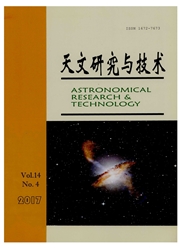

 中文摘要:
中文摘要:
随着新型大口径光学望远镜和高分辨率阶梯光栅光谱仪的广泛应用,更高精度的波长定标逐渐成为亟需解决和改进的一个重要环节.新兴的激光频率梳技术用于天文领域作为波长定标装置,不仅能够提供强度均匀、间隔相等且稳定的定标谱线,而且可以带来更加理想的视向速度精度(cm/s或10-10),为天体物理学中许多重大科学问题带来了有效的解决途径.主要介绍了我国首次使用掺镱光纤激光频率梳作为波长定标装置用于高分辨率阶梯光栅光谱仪(HRS,R~50 000)的测试结果,及其在8个echelle级次上(约40.0 nm,550.0nm~590.0 nm)范围内生成梳齿的谱线轮廓分析和定量的漂移跟踪.同时比较和讨论了国际同类定标装置的研究现状和特点,为以后进一步的完善和深入优化HRS-LFC(Laser FrequencyComb)系统奠定了基础.
 英文摘要:
英文摘要:
With expasion of applications of large-aperture telescopes and high-resolution echelle gratings, more accuate wavelength calibration is becoming increasingly important, and improving wavelength-calibration accuracies emerges as an urgent issue to be resolved. A newly intrduced technique is to use LFC (Laser Frequency Comb) devices to generate standard spectra for wavelength calibration. A standard spectrum from an LFC device not only has spectral lines of highly uniform intensities/wavelength intervals, but also makes it feasible to achieve higher precisions of radial-velocity measurements of various astrophysical objects ( to be on the level of a few cm/s or the relative-error level of 10-10). This should provide observational clues to a variety of important questions in astrophysics. In this paper we report the results of our first test of wavelength calibration of the Xinglong HRS (High-Resolution Spectrograph) of R-50000 by using an LFC device of a Yb fiber laser to generate the standard spectra. Our test focused on the performance of the HRS on 8 echelle orders ( spanning about 550. 0nm to about 590. 0nm). The perforamce is measured in the characteristics of comb-line profiles and instrumental wavelength drifts. We have aslo compared our results to those of foreign research groups as preparations for optimizing and improving the LFC system.
 同期刊论文项目
同期刊论文项目
 同项目期刊论文
同项目期刊论文
 期刊信息
期刊信息
